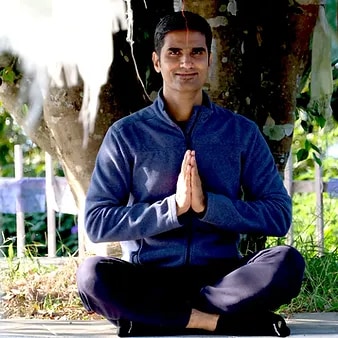Unveiling Brahmacharya: The Fourth Yama on the Yogic Path
by Hardik Mehta

In the eightfold path of yoga delineated by the sage Patanjali, the Yamas serve as foundational ethical principles guiding practitioners towards spiritual awakening and self-realization. These universal moral precepts, including Ahimsa (non-violence), Satya (truthfulness), Asteya (non-stealing), and Brahmacharya (moderation), form the bedrock of ethical conduct in yoga philosophy. Among these foundational principles lies Brahmacharya, the fourth Yama, which often gets distilled into the concept of celibacy. However, its essence transcends mere abstinence from sexual activity; it encompasses the wise management and conservation of vital energy across all aspects of life.
Understanding Brahmacharya
Brahmacharya, when translated, means “behavior that leads to the realization of the divine.” It invites practitioners to channel their energy towards spiritual evolution rather than dissipating it in hedonistic pursuits. While commonly associated with celibacy, it’s better interpreted as moderation in all sensual pleasures. It urges individuals to strike a balance in their physical, emotional, and mental energies to foster inner growth and higher consciousness.
Cultivating Balance in All Realms
Brahmacharya encourages a holistic approach to life, advocating for moderation in not just sexual matters but also in food, sleep, and sensory indulgences. By practicing moderation, one conserves vital energy, which can then be redirected towards spiritual pursuits, self-discovery, and creative expression.
Harnessing Sexual Energy
Sexual energy is a potent force, capable of both creation and destruction. Brahmacharya teaches individuals to harness this energy wisely, recognizing its power to either uplift or deplete. Instead of suppressing sexual urges, practitioners are encouraged to transmute this energy towards higher endeavours such as artistic pursuits, intellectual endeavors, or spiritual practices like meditation and yoga. Through practices like meditation, yoga, and creative pursuits, practitioners learn to harness and redirect this powerful energy towards higher states of consciousness.
The Role of Relationships
While celibacy is often associated with Brahmacharya, it doesn’t necessarily mean abstaining from intimate relationships. Instead, it emphasizes the cultivation of healthy, respectful connections that uplift both individuals involved. By fostering relationships grounded in mutual respect, understanding, and support, practitioners can navigate the complexities of human connection while staying aligned with the principles of Brahmacharya.
Mindful Consumption
In today’s world of excess, practicing Brahmacharya extends to mindful consumption of not just food and material possessions but also information and media. By discerning what we allow into our minds and bodies, we can prevent unnecessary depletion of energy and maintain clarity of thought. By observing our thoughts, emotions, and actions, we become aware of how we utilize our energy. Mindful consumption of food, media, and information allows us to conserve energy and maintain clarity of mind, essential for spiritual growth.
The Practice of Self-Discipline
Brahmacharya calls for self-discipline and restraint, recognizing that true freedom arises from mastery over one’s impulses and desires. By cultivating awareness of our thoughts, emotions, and actions, we can choose consciously rather than being driven by unconscious urges.
Integrating Brahmacharya into Daily Life
Incorporating Brahmacharya into daily life requires mindfulness and intentionality. It involves observing our habits and tendencies, identifying areas of excess, and making conscious choices to redirect our energy towards higher pursuits. This may involve establishing a balanced routine, setting boundaries in relationships, or dedicating time to spiritual practices.
Benefits of Practicing Brahmacharya
The practice of Brahmacharya yields numerous benefits beyond the preservation of energy. It fosters mental clarity, emotional stability, and spiritual growth. By cultivating inner balance and harmony, practitioners experience greater peace, fulfilment, and alignment with their true selves.
The Synergy Between Yoga Practice and Brahmacharya
Yoga, with its holistic approach to health and well-being, offers profound insights and practices to align with the ethical principles of the Yamas, including Brahmacharya. Through the integration of yogic techniques and philosophy into our lives, we can cultivate balance, moderation, and mindful use of energy, thus deepening our understanding and practice of Brahmacharya.
Yoga Asanas: Cultivating Physical Balance- The practice of yoga asanas (postures) fosters physical balance, strength, and flexibility. By engaging in a regular yoga practice, individuals learn to listen to their bodies, respect their physical limitations, and cultivate a sense of moderation in their physical activities. This awareness and balance in the body lay a strong foundation for embracing Brahmacharya in all aspects of life.
Pranayama: Harnessing Life Force Energy- Pranayama, the practice of breath control, plays a crucial role in harnessing and directing prana, or life force energy. Through specific breathing techniques, practitioners can regulate their energy levels, calm the mind, and enhance mental clarity. By incorporating pranayama into their daily routine, individuals develop the awareness and control necessary to channel their energy in alignment with the principles of Brahmacharya.
Meditation: Cultivating Mental Discipline- Meditation serves as a powerful tool for developing mental discipline and inner awareness. Through meditation practices, individuals learn to observe their thoughts, emotions, and impulses without attachment or judgment. This heightened awareness allows them to recognize patterns of excess and cultivate a sense of inner balance and harmony, essential for practicing Brahmacharya in daily life.
Yoga Philosophy: Understanding the Nature of Desire- Central to the philosophy of yoga is the recognition of the transient nature of desires and the importance of cultivating contentment (santosha). By studying yogic texts and teachings, practitioners gain insight into the nature of desire and the consequences of excessive indulgence. This understanding empowers them to make conscious choices and cultivate moderation in their pursuit of pleasure, thus aligning with the principles of Brahmacharya.
Brahmacharya, the fourth Yama on the yogic path, invites individuals to embrace moderation in all aspects of life. By wisely managing and conserving vital energy, practitioners can cultivate inner harmony, spiritual evolution, and a deeper connection with the divine. Through mindful practice and self-discipline, Brahmacharya empowers individuals to lead fulfilling lives aligned with their highest aspirations.
If you are looking for Pranayama course in Mumbai or meditation course in Mumbai, Sayujya Yoga’s 200 Hours Teacher Training Course (TTC) offers a holistic approach to yoga education. Through in-depth study, practical application, and experiential learning, students explore the timeless wisdom of yogic texts, such as the Yoga Sutras of Patanjali. The curriculum includes teachings on Brahmacharya and other Yamas, providing students with a deep understanding of these ethical guidelines and their practical relevance in modern life. Through asana practice, pranayama, meditation, and philosophical discussions, students are guided on a transformative journey towards self-discovery, inner harmony, and spiritual growth. With a faculty of experienced teachers and a supportive learning environment, Sayujya Yoga’s TTC ensures that students graduate with a comprehensive understanding of yoga philosophy and the practical tools to embody its principles both on and off the mat.
About the Author

Hardik Mehta
Hardik is an E-RYT 500 & YACEP (Yoga Alliance Continuing Education Provider), Yoga Alliance, USA. He has been practicing yoga for the last 9 years. Prior to finding his true calling in Yoga, he was working with various corporates for 12 years in the Retail and eCommerce sector.
